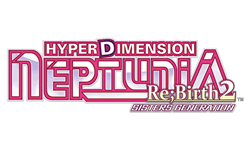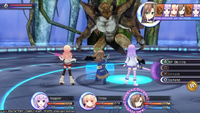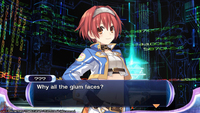|
|
 |
PLATFORM
|
Vita
|
BATTLE
SYSTEM
|
 |
INTERACTION
|
 |
ORIGINALITY
|
 |
STORY
|
 |
MUSIC
& SOUND
|
 |
VISUALS
|
 |
CHALLENGE
|
Moderate
|
COMPLETION
TIME
|
20-40 Hours
|
|
OVERALL

|
+
Great boss battles
+
Entertaining battles system
+
Enjoyable cast of characters
-
Boring main plot
-
Dungeons reused multiple
times
-
World is a bit lacking in
content
|
Click
here for scoring
definitions
|
|
|
Hyperdimension
Neptunia Re;Birth2: Sisters Generation is a
port of the Neptunia series' second entry.
While moving from PS3 to the Vita may seem like a
downgrade, the result proves to be very
well-suited to Sony's portable. Sisters
Generation's tale of the CPU candidates,
meant to be references to portable gaming systems,
definitely has its share of unmistakable issues.
Though plenty of good gaming related humor is
present in the world and the cast is likeable, the
overall story isn't very good. There are some
issues in the realm of gameplay as well, but
thankfully on the whole the battle system is good
fun. Combined with the humor that is present, the
overall experience is an enjoyable one.
For those
unfamiliar with the Neptunia series, it
takes place in Gameindustri, a fantasy world full
of references to games and game culture. The
countries in the world are ruled by goddesses
representing the various consoles, with the title
Neptunia being a reference to Sega. The
world is rife with jokes and references of all
sorts, so just poking around and finding
everything the developers included can be
fun. Most references are obvious, but some
are more subtle and may fly under the radar of
many players. On the other hand, the overall plot
leaves a lot to be desired.
The game begins
with the Goddesses from the first game, also
called CPUs, imprisoned by a powerful enemy. The
CPU candidate Nepgear, an obvious Game Gear
reference, is also imprisoned but quickly freed by
Iffy and Compa, barely-veiled representations of
Idea Factory and Compile Heart. If this all sounds
very absurd it largely is. An enemy organization
promoting game piracy serves as the focus of the
story, but this premise is sadly underutilized
outside of a few elements and enemy names. The
cast of characters entertains, especially the
playable characters representing various game
companies and consoles. The main plot on the other
hand, never develops and eventually ends without
much of a satisfying resolution. The antagonists
are especially disappointing, coming off mostly as
annoying, creepy, or just boring. It's a shame, as
there's plenty that could have been done with the
goofy premise, but at least the playable cast
offers a good deal of entertainment.
 Boss fights are
usually as intimidating as they
look. Boss fights are
usually as intimidating as they
look. |
|
Though it follows
the overall gameplay model Idea Factory has used
for everything from Mugen Souls to Fairy
Fencer F, Sisters Generation manages
to provide a solid experience. The setup is
simple: the world map is a quick selection of
locations for players to go, towns are just menus,
and dungeons are relatively small areas to
explore. That's not to say there isn't a great
deal of content, as plenty of side quests that
require tracking down specific creatures and
items, party conversations, and character
customization are available for perusal.
Those looking for a detailed world to explore,
however, will be left disappointed.
Dungeons and
combat are where the game puts its best foot
forward. Dungeons are simple, but with enough
branches to not feel sorely lacking. They have a
nice variety of visual layouts, though these tend
to be reused throughout the experience. The player
has the ability to jump during exploration, but
oddly this serves almost no function. Similar to
many games that show enemies on screen during
dungeon exploration, the player can try to time an
attack for getting the drop on enemies, while the
foes will go first if this fails.
Combat is turn
based, and each character can freely move around
the battlefield to get into position for attack
during her turn. When using regular attacks
players can mix and match several varieties of
strikes to create a combo. These either do more
damage, decrease the enemy's guard, or increase
the player's burst gauge used for super attacks.
Each character's weapons have different ranges and
attack radius so it is possible to hit multiple
enemies with these combos, and from a safe
distance for some of them. In addition, there are
special attacks that use a run of the mill MP
system, and the aforementioned super attacks that
are unlocked as the game progresses. Regular
battles are not overly challenging, but tend to
require strategy and intelligent use of special
abilities until a few levels have been gained in
each new dungeon. There are more challenging
enemies in the dungeons, which often are targets
for optional sidequests. These formidable foes
won't chase after the player, so they remain
completely optional.
 Falcom is easily
one of the coolest party
members. Falcom is easily
one of the coolest party
members. |
|
Boss battles tend to
be challenging and fun. They require careful
strategy and plenty of restorative items, plus a
bit of good luck on occasion. Once the player
unlocks super attacks for most party members,
these battles can turn into grind out affairs,
fighting to stay alive and building up to another
super attack. Most bosses heal HP every turn,
which further adds to the difficulty, especially
when much of the party is in need of recovery. In
the end, the combat absolutely steals the show.
This is aided by a great graphic engine that runs
much smoother than similar Idea Factory games on
the PS3, despite the Vita's hardware being less
impressive. This makes even easy and boring
encounters at least have some nice visual flare.
On the whole
the game has a nice look to it. Character
conversations are all told through 2D portraits,
but these move attractively and do a great deal
towards helping them feel less static. Battles and
dungeons use the same character and enemy models
to keep things consistent, and the graphical
pizzazz of the environments helps alleviate the
annoyance that results from visiting some of them
more often than necessary. Voice acting is mostly
good, which is impressive given some of the
off-kilter lines that show up in the script. A few
character voices prove to be annoying but
thankfully none in the primary cast. The rest of
the audio is pleasant without being memorable.
Hyperdimension
Neptunia Re;Birth2: Sisters Generation
proves to be a solid port on the Vita, one that
may even be technically superior to the PS3
rendition. The characters and world provide plenty
of goofy fun despite the lackluster main plot.
There's plenty of little gaming culture references
to track down, and the novelty of various consoles
and companies brought to life in the form of anime
girls is surprisingly entertaining. Its problems
are certainly hard to ignore, such as the world
not offering a ton to do except march through
dungeons that aren't very big and are reused too
often. The combat engine is fun though, especially
the boss battles, but the lack of a satisfying
plot can suck some of the fun out of it. Still, Sister's
Generation is a fun game, and certainly
worth checking out for any Vita user starved for
RPGs.
Review
Archives
|









